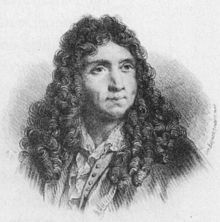Pierre Beauchamp

Pierre Beauchamp
Pierre Beauchamp or Beauchamps (French pronunciation: [pjɛʁ boʃɑ̃]; 30 October 1631 – February 1705) was a French choreographer, dancer and composer, and the probable inventor of Beauchamp–Feuillet notation. His grand-father was called Christophe (a musician) and his father, a violinist of the king's chamber, was simply called Louis. Following a custom of the time, Pierre Beauchamp was named Pierre after his godfather Pierre Vacherot, tailor of the queen's pages and a relative of the Beauchamps family.[1]
Biography
Beauchamp was born at
Court of Versailles after the death of Jean-Baptiste Lully in 1687; however, choreography and composition of music and ballets for the Jesuit Colleges became his primary occupation from 1697. He died at Paris
in 1705.
Writing some years after the actual events,
Raoul-Auger Feuillet, who published notated dance scores, and became known as Beauchamp–Feuillet notation
. It was slightly modified by Pierre Rameau in 1725, but continued to be used to record dances for the stage and for domestic use throughout the eighteenth century.
Two
pirouettes
and many ornamented steps, it contains no aerial beaten steps.
Selected works
With Molière and Lully
- Les Fâcheux, choreography, musical composition, orchestral director (1661)
- Le Mariage forcé (1664)
- Le Bourgeois gentilhomme, ballets (1669)
- Les Amants magnifiques (1670)
- Psyché, ballets (1671)
- Le Malade imaginaire, ballets (1673)
Original Choreography for Pierre Perrin
- Pomone (opera, 1671)
Choreography with Lully
- L'Impatience (1661)
- La Naissance de Vénus (1665)
- Alceste (1674)
- Atys (1676)
- Isis (1677)
- Le Triomphe de l'amour, avec Pécour (1681)
- Ballet de la jeunesse (1686)
References
External links
Wikimedia Commons has media related to Pierre Beauchamp.
- Facsimile of a 1748 edition of Rameau's book from The Library of Congress' An American Ballroom Companion.
- César UK Excerpt from Grove Dictionary entry on Pierre Beauchamp.
- Free scores by Pierre Beauchamp at the International Music Score Library Project (IMSLP)
